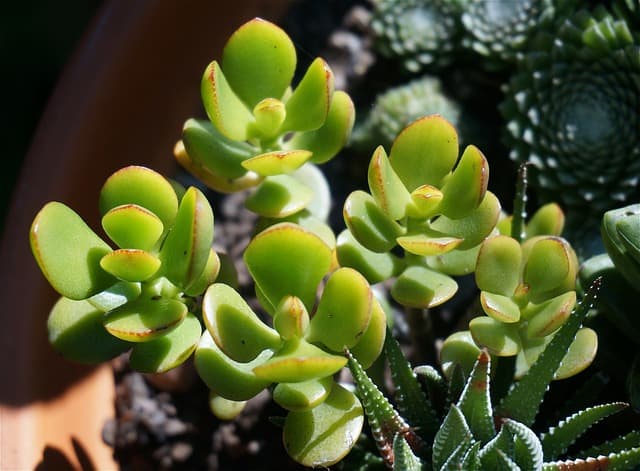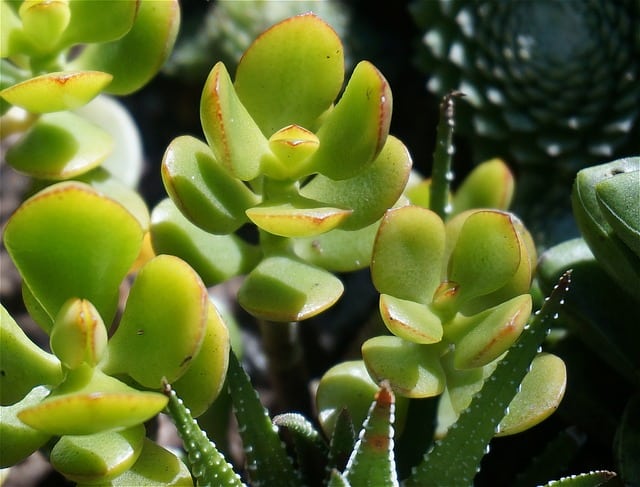Introduction to Jade Plants
Jade plants, or Crassula ovata, are succulents native to South Africa and Mozambique. Known for their vibrant, glossy, green leaves, these plants are a favorite among gardeners and houseplant enthusiasts for their minimal care requirements and longevity. They are often called money trees, reflecting their associations with good fortune and prosperity. Keeping a jade plant in your home or office can bring good luck and financial success.
These fascinating plants have a unique appeal that combines the exotic with the familiar. Their charming miniature tree-like appearance makes them a striking addition to any interior or exterior space. However, despite their hardy nature and aesthetic appeal, these plants can challenge those who want to expand their collection. This is where understanding how to propagate jade plants becomes crucial.
Propagating jade plants is an exciting endeavor that any plant enthusiast can undertake. This process allows you to grow new plants from a single-parent plant. With the proper knowledge and skills, you can quickly propagate your jade plants, ensuring a steady supply of these beautiful plants for your garden or indoor plant collection.
Understanding the Propagation Process
Propagation is the process of producing new plants from the parts of existing ones. In the case of jade plants, this can be done through stem cuttings or leaf cuttings. This process is relatively simple and can be carried out at home with essential gardening tools.
When propagating jade plants, it’s essential to remember that these are succulents. This means they have a unique set of needs compared to other plants. Succulents store water in their leaves, stems, and roots, which allows them to survive in arid conditions. Therefore, they require well-draining soil and infrequent watering to thrive.
In the propagation process, the cuttings or leaves are first allowed to dry and form a callus over the cut surface. This callus formation is crucial as it prevents the cutting from absorbing too much water and rotting. Once the callus has formed, the cutting can be planted in a suitable potting mix to develop roots and gradually grow into a new jade plant.

The Right Time to Propagate a Jade Plant
When it comes to propagating jade plants, timing is everything. The best time to breed a jade plant is during its active growing season, which typically falls between spring and early autumn. The plant will most likely successfully grow roots from a cutting during this period.
However, jade plants can be propagated anytime if kept in suitable conditions. Suppose you are propagating jade plants during their dormant period in winter. In that case, you may need to provide additional light and warmth to encourage root growth.
It’s important to note that although jade plants can be propagated at any time, the success rate may vary depending on the season. Therefore, if you are a beginner, starting your propagation journey during the active growing season is recommended to increase your chances of success.
How to Propagate Jade Plant from Stem: Step-by-Step Guide
Propagating a jade plant from stem cuttings is a straightforward process. Here’s a step-by-step guide on propagating a jade plant from the stem.
Step 1: Select a Healthy Stem
When choosing a stem for propagation, look for a healthy, mature stem free from disease or pests. The stem should be firm to the touch and have many leaves.
Step 2: Cut the Stem
Cut off a piece of the stem about 3-4 inches long using a sharp, sterilized knife or pruning shears. Make sure to make a clean cut just below a leaf node, as this is where new roots will form.
Step 3: Allow the Cut to Dry
After cutting the stem, let it dry out for a few days to a week until a callus forms over the cut end. This step is crucial to preventing rot when the cutting is planted.
Step 4: Plant the Stem Cutting
Once the callus has formed, you can plant the stem cutting in well-draining soil. Bury the cut end about an inch deep in the soil, ensuring the stem is upright.
Step 5: Water and Wait
Water the soil around the cutting and then wait. The cutting should develop roots and new growth in a few weeks to a month.
Remember, patience is vital when propagating jade plants. It may take several weeks to see signs of new growth, so be encouraged if you don’t see immediate results.
Tips for Successful Jade Plant Propagation
While jade plant propagation can seem intimidating, a few tips and tricks can make the process smoother. Here are some valuable tips for successful jade plant propagation:
- Use the Right Soil
Succulents like jade plants prefer well-draining soil to prevent waterlogging. A mix of regular potting soil and coarse sand or perlite can balance moisture and drainage.
- Be Patient
Patience is key in jade plant propagation. It can take several weeks for your cuttings to develop roots and show signs of growth.
- Provide Adequate Light
While jade plants can tolerate various light conditions, they prefer bright, indirect light. Too much direct sunlight can scorch their leaves, while too little light can lead to leggy growth.
- Water Sparingly
Overwatering is a common mistake in jade plant care. Water your jade plant cuttings thoroughly, then let the soil dry out completely before watering again.

Common Problems and Solutions When Propagating Jade Plants
Despite the relative ease of jade plant propagation, you may encounter a few problems. Here are some common issues and their solutions:
- Rotting Cuttings
If your jade plant cuttings turn black and mushy, they are likely rotting. This is usually caused by overwatering or planting the cuttings before forming a callus. To prevent this, allow the cuttings to dry thoroughly and form a callus before planting and water sparingly.
- No Root Formation
If your cuttings are not forming roots after several weeks, they may need more light, or the temperature may be too low. Try moving them to a brighter location and providing additional warmth.
- Leaves Falling Off
If the leaves on your jade plant cuttings are falling off, it may be a sign of stress. A sudden change in light, temperature, or watering can cause this. Try to maintain consistent care conditions to avoid stressing your cuttings.
Jade Plant Care After Propagation
Once your jade plant cuttings have successfully rooted and started to grow, they will need ongoing care to thrive. Jade plants prefer bright, indirect light and a well-draining soil mix. They should be watered thoroughly and allowed to dry out completely before watering again.
Jade plants also prefer a consistent temperature and humidity level. They can tolerate various temperatures, such as a moderate room temperature between 65 and 75 degrees Fahrenheit.
It’s also important to fertilize your jade plants regularly to support their growth. Use a balanced, water-soluble fertilizer diluted to half strength and apply it every two weeks during the growing season.
The Benefits of Propagating Jade Plants
Propagating jade plants not only allows you to expand your collection of these beautiful succulents, but it also offers several other benefits. For one, it’s a cost-effective way to grow more plants. Rather than buying new plants, you can propagate your own from a single-parent plant.
Additionally, propagating jade plants can be a rewarding hobby. It’s exciting to watch a small cutting grow into a full-sized plant. Plus, propagated plants make great gifts for friends and family.
Finally, propagating jade plants can help preserve their genetic diversity. By multiplying your plants, you can help maintain your specific plant’s unique characteristics, contributing to this species’s overall biodiversity.
How to Propagate a Jade Plant: Expert Advice
If you’re new to propagating jade plants, don’t worry. Even experienced gardeners can learn something new when it comes to propagation. Here’s some expert advice on how to propagate a jade plant:
- Choose the Right Cutting: Not all cuttings are created equal. A healthy, robust cutting is more likely to root successfully than a weak or diseased one.
- Prepare Your Cutting Correctly: Let your cutting dry out and form a callus before planting. This is crucial to preventing rot and encouraging healthy root development.
- Plant in the Right Soil: Jade plants prefer well-draining soil. A mix of regular potting soil and perlite or coarse sand can balance moisture and drainage.
- Provide Adequate Light and Warmth: Jade plants prefer bright, indirect light and moderate temperatures. Make sure to provide these conditions to encourage successful root development.
- Be Patient: Propagation is not an overnight process. It can take several weeks for your cuttings to root and grow. Be patient and give your plants the time they need to develop.
Conclusion
Learning how to propagate jade plants successfully can open up a world of possibilities for expanding your collection of these beautiful succulents. You can quickly bear your jade plants with patience, the right conditions, and a little know-how. Remember, the key to successful propagation is understanding the needs of your specific plant and providing the proper care. Happy propagating!

